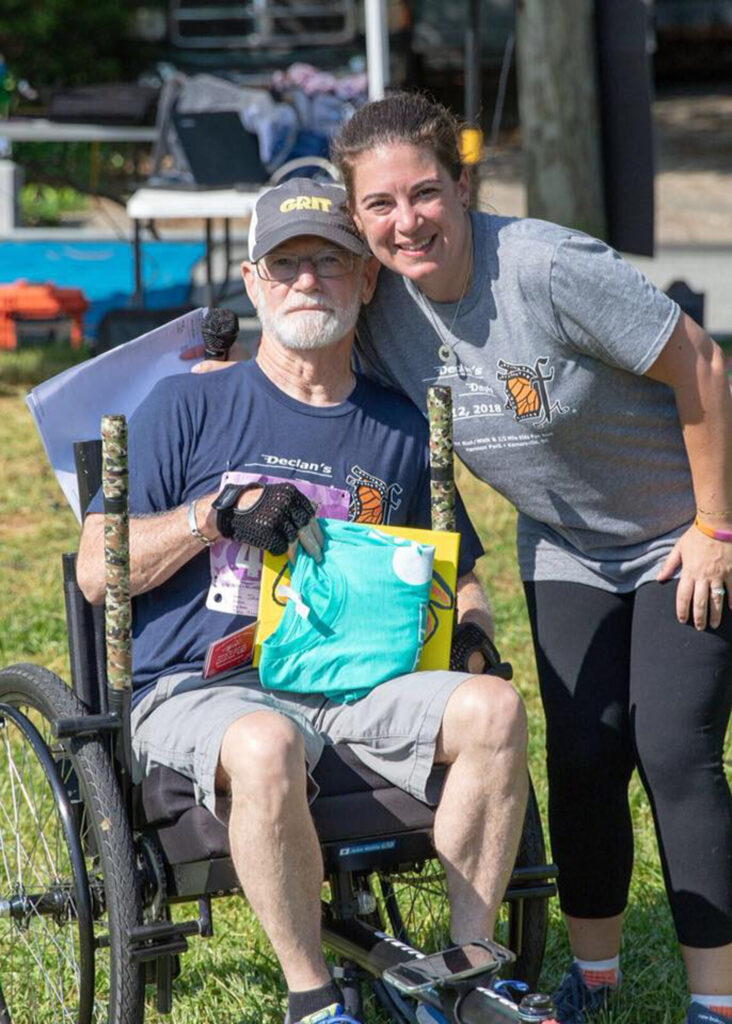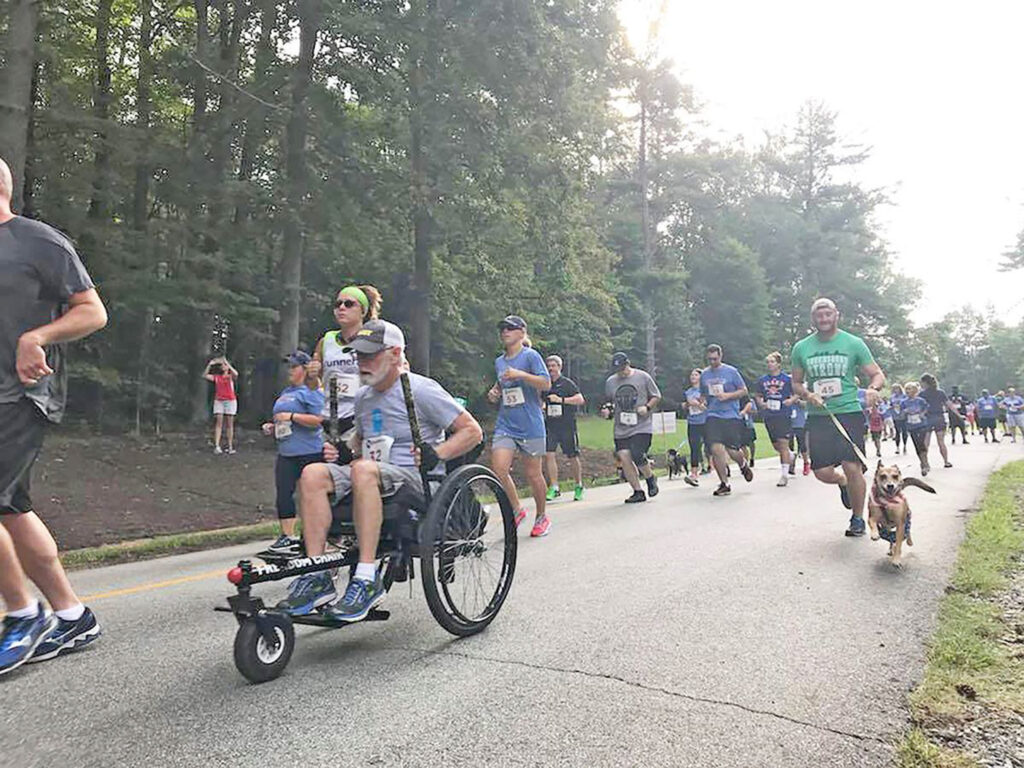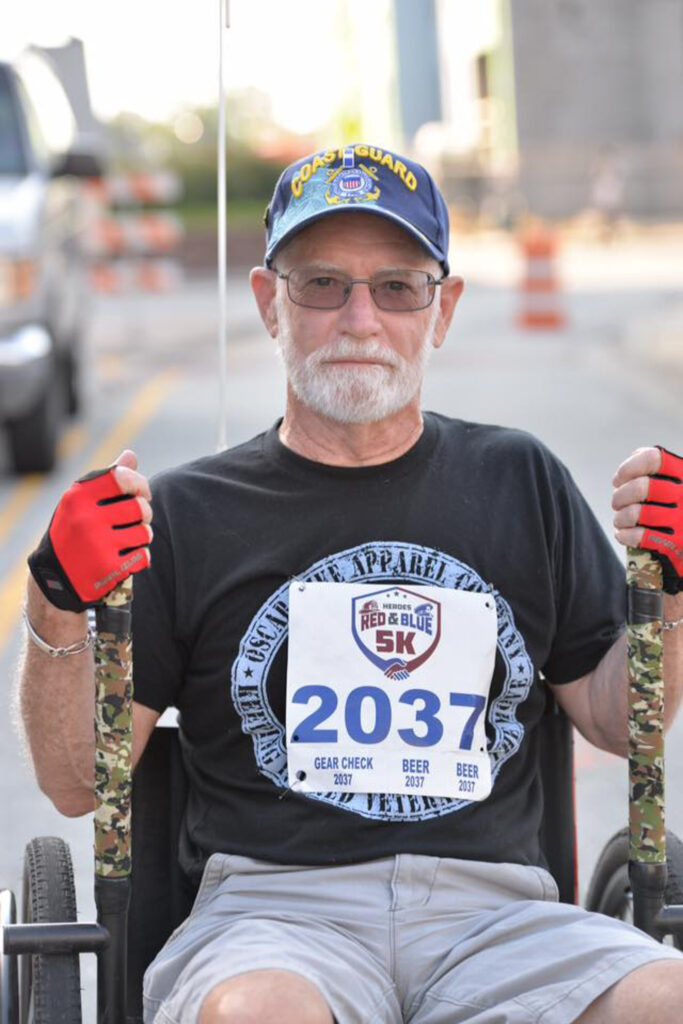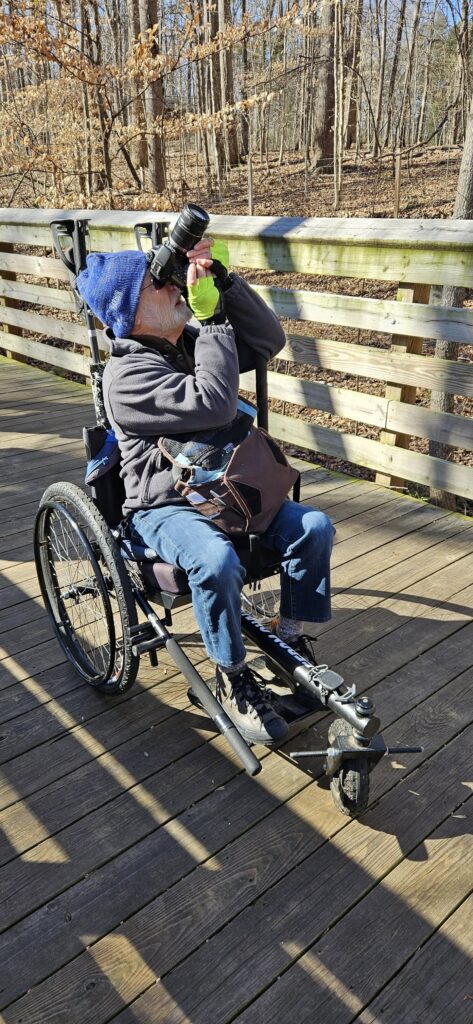The GRIT team was honored to sit down with longtime GRIT Freedom Chair rider, accessibility advocate, United States Army and Coast Guard veteran, and all-around great guy, John Hollis.
If you haven’t already read part one of this two-part interview, click this link and give it a read! If you’ve caught up and are ready for part two, continue reading below.
GRIT: John, you’ve done many road races in your GRIT Freedom Chair and have mentioned the importance of racing etiquette. Can you tell us why 5K etiquette is so important?
John Hollis: For me, it’s simply about being aware. You don’t want to hurt anybody. Since I’m in my chair and most other racers are using their legs, I stay off to the right. I let them pass me. In my last few races, I would start between ten and thirty seconds ahead of the rest of the racers to avoid a jam-up right at the start.

John: And, I always used flags on my chair. The runners are running along, concentrating on themselves, and they just don’t see me up ahead. I’ve had a few come up almost on top of me from the back.
GRIT: With so many people darting around such a confined space, everyone needs to be on alert.
John: Yea, it’s just about being aware of yourself in space and the world around you. I think we all need to be better at it.
One time, I ran a race that was on a greenway, but the greenway was just a sidewalk. I had bicyclists within three or four inches on my right side and people running within three or four inches on my left side. It was way too tight, so I never ran that race again.
GRIT: What does the night before a race look like for you?
John: Well, when I was first doing them and I was in great shape—I now consider myself to be in [laughs] “medium-good” shape—I wouldn’t go out the night before the race. I would rest my body. But, as I got better and was routinely going out and doing three, four, five miles for fun, I stopped doing anything different before a race. At that point, a 5K was just another daily workout, at about the same speed, requiring about the same amount of work. Your body learns to handle it, even if you’re busting your hump trying to go as fast as you can.
GRIT: Makes sense.
“When I was in Vietnam, I was a helicopter medic, and I was the only medic in the helicopter. So I did what I could, one day at a time. “
John: Around here, there are no flat races. There are always hills, some worse than others. But I was doing hills every day, so race time wasn’t much different for me. On race day, I would get up in the morning, have a cup of coffee and maybe something small to eat, and that would be it. I’d go out and do my 30-45-minute race, and I’d be done.
I also just hate having sore muscles. So, when I’m getting back in shape, I go out and do what I can at the speed I’m most comfortable. After awhile of that, I can eventually go a little faster, and then a little faster than that. Just build up. You start to feel more comfortable going faster and farther.

GRIT: Right, just a little bit at a time.
John: If you can be consistent with it, you can do more because your heart gets better, your muscles and your joints are now used to it, and you can go a little farther and faster. But never hurt yourself just to go faster.
GRIT: Have you ever forgotten to take your own advice and pushed too hard?
John: Yea, it’s not worth it. If you get hurt, you put yourself back. One time I rode when I had the flu and I couldn’t do anything after that for a week. I was also 76 years old at that point, and as I get older it takes me longer to build back to where I was.
GRIT: When you have a setback or you have to take some time off from working out, where do you get the drive to get back into it?
John: Well, when I was in the service and for a lot of the time afterward, I was doing my job by myself. Like, for instance, when I was in Vietnam, I was a helicopter medic, and I was the only medic in the helicopter. So I did what I could, one day at a time. You simply do that.
GRIT: Understood. Look only as far forward as you can.

John: Yea, and what I don’t do when I work out is think “Let’s see. I want to do a 5K in under 30 minutes two weeks from now.” I don’t do that. I simply say—one day at a time—push a little bit, and then push a little bit more. I just do that because I’ve often been alone when I’ve needed to do things.
Don’t worry about next week. Don’t worry about what you’re gonna do a month from now. Go out. Do it today. And if you’re a little slower than yesterday, that’s okay. Maybe you’re a little tired. Maybe you’re on a different route. But just do it today.
GRIT: That is great advice.
John: It’s a little bit like people who are trying to stop a bad habit like smoking. Don’t take that smoke break today. Then, repeat the same thing the next day, and the next.
GRIT: How is the chair itself doing these days? Is everything in good shape after all of these miles?
John: Well, I put about 3,000 miles on my first chair before it finally gave up me. I replaced it some time ago and things have been good since. The fact is, I was talking to someone at GRIT and they said “It’s been awhile since we’ve heard from you!” And I said, “Well, it’s because the chair hasn’t broken!”
GRIT: What kind of maintenance and tune-ups do you perform on your chair throughout the year?
John: I have to adjust the parking brakes whenever I swap from heavy-duty off-road tires to racing tires. It’s a pain to reach one of the screws, but that’s it. Otherwise I go to a bike shop for the tire swaps. It’s one of the great things about this chair—any bike shop knows what to do because the parts aren’t super specialized.
I used to put the chair on a box or a plastic can of cat litter to jack it up and work on it. I’d use whatever I happened to have that fits. Other than the tires, I do everything myself. Another great thing about it is that it only takes what, four or five tools? It’s so easy to work on the whole thing.
“One day at a time. Push a little bit, then push a little bit more…Don’t worry about next week. Don’t worry about what you’re gonna do a month from now. Go out. Do it today.”

GRIT: Good! That’s how it should be.
John: At worst, I get a part from you guys. When I ordered my second chair, the person on the phone told me it would take between 4-6 weeks to ship. I explained before ordering that I had a race coming up, so before the VA even approved it, you guys had it all built up and ready to go. After I ordered, you shipped it out in just three days. That kind of service—you don’t get that everywhere.
GRIT: How did that race go, anyway?
John: Well, as it happens, it was the only race I’ve ever done that I wanted to drop out because it was so freaking cold and windy! The course also didn’t have little dips and hills—instead, it was a mile and a half downhill, a mile and a half uphill, etc. The wind was awful. It was cold.
But you guys did the extra for me, and you always have. The customer service is…it’s what it’s supposed to be everywhere.

GRIT: That means the world, John. I’ll make sure the whole team hears this.
John: I also like how you guys now have the kids chair [the GRIT Junior, link here], and rollators. I have to use a special rollator myself, for now, because I gotta be real careful with my chest area following open heart surgery. But you’re offering these advantages to people so they can get out. They’re not stuck in their houses. And, you know, sometimes people only need a little bit of help to stay sane—getting out of the house gives you a better chance of staying sane. You’re not isolated.
GRIT: Agreed!
John: It’s one of the biggest problems for people with disabilities. You can get stuck. Your world gets small. GRIT allows you to go back to the big world and get out there.
Thank you, John, for your time, conversation, and insight. Whether offering advice to new GRIT Freedom Chair users online, reminding us all to stay consistent, or flooring us with your own miles and speeds, you continually remind us what it’s all about.
To connect with John and other GRIT Freedom Chair riders, head over to Beyond the Pavement on Facebook. And, if you’ve been using your own GRIT Freedom Chair and would like to share any part of your story, send us a note at info@gogrit.us—we’d love to talk!